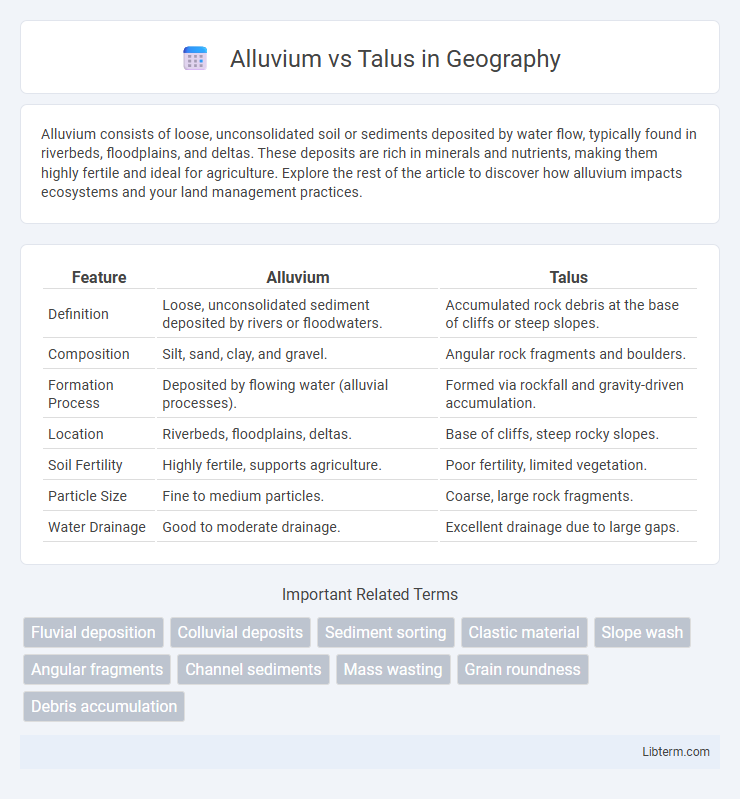Alluvium consists of loose, unconsolidated soil or sediments deposited by water flow, typically found in riverbeds, floodplains, and deltas. These deposits are rich in minerals and nutrients, making them highly fertile and ideal for agriculture. Explore the rest of the article to discover how alluvium impacts ecosystems and your land management practices.
Table of Comparison
| Feature | Alluvium | Talus |
|---|---|---|
| Definition | Loose, unconsolidated sediment deposited by rivers or floodwaters. | Accumulated rock debris at the base of cliffs or steep slopes. |
| Composition | Silt, sand, clay, and gravel. | Angular rock fragments and boulders. |
| Formation Process | Deposited by flowing water (alluvial processes). | Formed via rockfall and gravity-driven accumulation. |
| Location | Riverbeds, floodplains, deltas. | Base of cliffs, steep rocky slopes. |
| Soil Fertility | Highly fertile, supports agriculture. | Poor fertility, limited vegetation. |
| Particle Size | Fine to medium particles. | Coarse, large rock fragments. |
| Water Drainage | Good to moderate drainage. | Excellent drainage due to large gaps. |
Introduction to Alluvium and Talus
Alluvium consists of loose, unconsolidated soil or sediment deposited by water, typically found in riverbeds, floodplains, and deltas, rich in silt, sand, clay, and gravel. Talus refers to angular rock fragments accumulated at the base of cliffs or steep slopes, formed primarily through physical weathering and erosion. Both geological materials play crucial roles in landscape formation and influence soil fertility, drainage, and slope stability.
Defining Alluvium: Key Characteristics
Alluvium consists of loose, unconsolidated sediment deposited by rivers and streams, primarily composed of sand, silt, clay, and gravel. It is typically found in floodplains, riverbeds, and deltas, characterized by well-sorted, layered materials due to water transport. Unlike talus, which forms from rock debris accumulated at the base of cliffs through gravity-driven processes, alluvium results from fluvial activity and supports fertile soil development.
Understanding Talus: Essential Features
Talus refers to the accumulation of rock debris at the base of cliffs or steep slopes, formed primarily through physical weathering processes such as freeze-thaw cycles. These angular rock fragments vary in size and create unstable slopes characterized by high porosity and rapid drainage. Talus deposits differ from alluvium, which consists of finer, well-sorted sediments transported and deposited by water.
Formation Processes: Alluvium vs Talus
Alluvium forms through sediment deposition carried by flowing water, typically in riverbeds, floodplains, and deltas, resulting in well-sorted, fine-grained materials like sand, silt, and clay. Talus accumulates from mechanical weathering and gravitational forces, consisting of angular rock fragments at the base of cliffs or steep slopes, reflecting rapid physical breakdown without water transport. The key distinction lies in alluvium's fluvial deposition versus talus's lithified, gravity-driven accumulation.
Composition Differences Between Alluvium and Talus
Alluvium consists primarily of fine-grained sediments like silt, sand, clay, and organic material, deposited by flowing water in riverbeds and floodplains, resulting in well-sorted and layered deposits. Talus is composed mainly of angular rock fragments and coarse debris accumulated at the base of cliffs or steep slopes through physical weathering and gravity, lacking fine particles and organic content. The compositional difference lies in alluvium's sedimentary, water-transported materials versus talus's mechanically weathered, gravity-driven rock fragments.
Common Locations and Environments
Alluvium commonly accumulates in riverbeds, floodplains, and deltas where flowing water deposits fine sediments such as silt, sand, and clay. Talus is typically found at the base of steep slopes, cliffs, and mountain ridges where rock fragments collect from mechanical weathering and gravity-driven processes like rockfalls. Both materials form distinct geological environments influencing soil development, vegetation patterns, and landscape stability.
Role in Landscape Evolution
Alluvium significantly shapes landscape evolution by transporting and depositing fine sediments in floodplains, riverbeds, and deltas, contributing to soil fertility and creating flat, stable landforms. Talus accumulates at the base of steep slopes, influencing slope stability and driving geomorphological changes through rockfall and debris buildup. Together, these materials facilitate different erosional and depositional processes crucial for the continuous reshaping of terrestrial landscapes.
Importance in Soil Fertility and Agriculture
Alluvium, composed of fine, nutrient-rich sediments deposited by rivers, plays a crucial role in enhancing soil fertility and supporting productive agriculture due to its high organic matter content and moisture retention capacity. In contrast, talus consists of coarse, fragmented rocks accumulating at the base of slopes, offering limited nutrient availability and poor water retention, making it less suitable for crop cultivation. Understanding the distinct properties of alluvium and talus helps optimize land use and improves soil management practices in agricultural planning.
Alluvium and Talus in Geotechnical Applications
Alluvium consists of loose, unconsolidated sediments deposited by water, making it highly permeable and suitable for foundation construction in geotechnical applications due to its ability to drain and compact well. Talus, composed of angular rock fragments accumulated at the base of slopes, presents challenges such as poor cohesion and irregular particle distribution, leading to potential instability in earthworks and slope reinforcement. Engineers must evaluate the mechanical properties of alluvium and talus to ensure appropriate soil stabilization techniques and foundation design in varying geological contexts.
Summary: Distinguishing Alluvium from Talus
Alluvium refers to unconsolidated sediments deposited by rivers and streams, typically consisting of silt, sand, clay, and gravel that accumulate in floodplains and deltas. Talus consists of angular rock fragments and debris that collect at the base of cliffs or steep slopes, formed mainly by mechanical weathering and rockfall processes. The primary distinction lies in their origin and composition: alluvium is transported and sorted by water, whereas talus is a product of gravity-driven accumulation of angular, unsorted rock fragments.
Alluvium Infographic

 libterm.com
libterm.com